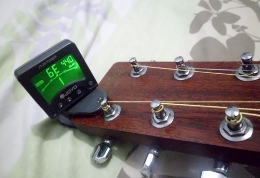Tuning
Is it best to tune “by ear”, or should you use an Electronic Tuner?
Electronic tuners are invaluable to beginning students. It is difficult to
know what an ‘in tune’ instrument sounds like if you only get your guitar
tuned once a week at your lesson. True, they (tuners) are imperfect, but it
is much better than playing a piece out of tune 5 days out of 7.
Even ‘advanced’ players benefit from electronic tuners, e.g. if you have a cold and can’t tune perfectly by ear!
******
TUNING DOWN A 1/2 STEP, AND HOW DO I DO IT
by Peter Schmidt
The term “Tuning down a half step”, means that all strings on the guitar are tuned down 1 note. For example, the low E string is normally tuned to E. However, tuning it down one step, and open E string will not play a Eb. This goes for the other strings as well. So now the open string tuning will be as follows (from low E to high E) Eb Ab Db Gb Bb Eb
The best way of doing this is with an electronic tuner, and fretting the string on the first fret. So if you play the lower E string (now tuned to Eb), and fret the string at the first fret, the note is E (but the open string is Eb). Another way is tuning the lower E string to Eb, and then tune the rest of the strings to this (i.e.. play 5-fret lower E, play open A string (remember, they are now 1/2 tone lower so Eb, Ab)
An advantage in tuning down half a step is that you can use heavier gauge strings also, as the tension for the heavier gauge will be equal to the lighter gauge (as along as you go up by 1 gauge at a time)
DROPPED D-TUNING
Dropped D tuning is when you tune the lower E string to D instead. The rest of the string remain to the same normal tuning. The tuning of the guitar now looks like this D A D G B E. An example of a song that uses this is Queen’s Fat Bottomed Girls.
TUNING 12 STRING GUITARS
by Peter Schmidt
A lot of people seem to have trouble with tuning 12 string guitars. Here’s basically how to do it.
Starting off (with the guitar in your lap and looking down on it), the strings are arranged for each string position with the lighter gauge strings go on the top and the normal six string set on the bottom. These strings alternate (i.e. light gauge E, heavy gauge E , light gauge A, heavy gauge A etc. all the way to the high E position).
In essence, all strings are tuned to the same notes as on a six string guitar (i.e. E A D G B e). However, the lower four string pairs are tuned an octave apart in respect to each other. So for the low E position, the lighter gauge string is tuned and octave higher than it’s partner, the heavier gauge string. The heavier gauge string is tuned as you normally do on a six string guitar. And so is repeated for the next three sets of strings (A, D and G). The B and high e strings are tuned to the same pitch.
As some older 12 string guitars can’t cope with the strain put on the neck from standard concert pitch tuning, some people drop tune them. That’s is, instead or tuning to E, they might tune down to Eb, D or even Db.
To play in the right key, guitarists normally capo up to whichever key they are to play in. This doesn’t sound as good as free tuning, but it’s a way of preserving your neck life. Recommended capo’s are Kyser and Schubb.
It’s also a good idea to use light gauge strings to help reduce neck stress.
*******
WHY TUNE DOWN?
by John Tapella
Heavy Rock bands use lowered tunings because they produce thicker and heavier guitar sounds. They place the guitar pitch somewhere in between a standard guitar tuning and a bass guitar tuning. The thundering low, growling rhythms sometimes have limitations. Not all solos sound great at the lower pitch and sometimes there is so much slack on the strings, chords lose their distinct quality and sound mushy.
*******

